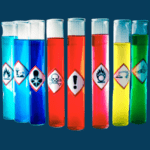The Importance of ASTM D1308 Testing for Household & Industrial Cleaners
The Importance of Surface Compatibility in Cleaners
When it comes to cleaning products, whether for home or industrial use, consumers and businesses demand safety, effectiveness, and compatibility across a wide range of surfaces, from sleek kitchen countertops to industrial-grade floors. Each surface type presents its own challenges. Manufacturers need a reliable way to ensure their products won’t cause damage to these diverse surfaces. This is where ASTM D1308 testing plays a crucial role. This widely accepted standard method enables manufacturers to assess the impact of cleaning products on various materials, thereby ensuring safety and consumer satisfaction.
In this article, we’ll explore the significance of ASTM D1308 testing for multi-surface cleaners, discuss how the test works, review common surface reactions, and the advantages it offers cleaner manufacturers.
Why Surface Compatibility Testing is Critical for Multi-Surface Cleaners
Surface compatibility is a key factor when developing both household and industrial cleaning products. Consumers and businesses want a cleaner that is versatile enough for use on a variety of materials, including stainless steel, glass, wood, and more. However, chemicals that work well on one surface may cause damage to another. For instance, an acidic cleaner may be perfect for ceramic but could harm delicate marble. This is why thorough testing for surface compatibility is essential.
Testing not only helps manufacturers avoid costly consumer complaints but also serves to substantiate marketing claims. By providing evidence that a cleaner is safe for multiple surfaces, manufacturers can enhance their brand reputation and build consumer trust, thereby gaining a competitive advantage in a crowded market.
What is ASTM D1308 Testing?
ASTM D1308 is a standard test method used to evaluate the effects of household and industrial chemicals, including cleaners, on various surfaces. This testing involves applying the cleaner to different materials under controlled conditions that mimic real-world usage. The method includes three types of spot tests: open, covered, and an immersion test.
- Open Spot Test: In this test, the cleaner is applied directly to the surface and left exposed to air, simulating typical cleaning conditions.
- Covered Spot Test: The cleaner is applied to the surface and covered with a watch glass. In these mimicking real-world scenarios, such as when an object is placed on a freshly cleaned surface, the chemical can be trapped in close contact, or when it seeps beneath items like furniture or countertops.
- Immersion Test: A suitably prepared panel is immersed in the cleaner.
To maintain consistency, the testing conditions are standardized to a temperature of 23 ± 2°C (73.5 ± 3.5°F) and a relative humidity of 50 ± 5%. This replicates typical household or industrial environments, helping to predict how the cleaner will perform under normal usage conditions.
In the Immersion test the panels will be immersed to a depth of 50% in the test sample, at a temperature and length of time appropriate to the cleaner usage.
Common Observed Deleterious Effects from Cleaning Products
Through ASTM D1308 testing, manufacturers can identify and document deleterious effects that a cleaner might cause. Some of the most common types of damage include:
- Discoloration: Fading, staining, or discoloring of the surface is often a sign that the cleaner is too harsh.
- Gloss Change: Cleaners can alter the surface’s shine, either enhancing or dulling its gloss, which may be undesirable.
- Blistering: Raised bubbles or blisters that form on the surface as a result of chemical reactions.
- Softening: Certain chemicals can soften surfaces, making them more prone to damage.
- Swelling: Some cleaners may cause surfaces to absorb moisture, leading to swelling or warping.
- Loss of Adhesion: Cleaners can weaken coatings, finishes, or adhesives, causing them to peel or flake off.
- Etching: Certain chemicals, particularly acids, can cause small pits or rough patches on the surface.
- Watermarks: Water residue left on surfaces can create unsightly marks that are difficult to remove.
These reactions enable manufacturers to understand the limitations and compatibility of their products across various materials.
Why ASTM D1308 Testing is Beneficial for Multi-Surface Cleaners
For manufacturers, ASTM D1308 testing offers several key advantages:
- Enhanced Product Safety: Ensuring that a cleaning product is safe for multiple surfaces reduces the risk of damage, leading to fewer consumer complaints and returns.
- Improved Product Formulations: If adverse reactions are identified, manufacturers can use the test results to refine their formulations, thereby enhancing compatibility across various surfaces.
- Building Consumer Trust: Products that have undergone thorough testing are more likely to gain consumer confidence. Shoppers are increasingly seeking cleaners that are safe for use on various materials, and having test results to support those claims can be a significant selling point.
- Credible Marketing Claims: Testing results can be leveraged in marketing materials to substantiate claims that a cleaner is safe for use on multiple surfaces, which can set a product apart in a competitive marketplace.
Conclusion: The Role of ASTM D1308 Testing in Cleaner Safety and Marketability
ASTM D1308 testing is crucial for manufacturers of cleaning products who want to ensure their products are safe for use on a wide range of surfaces. By identifying potential issues and providing reliable data, this testing not only prevents damage but also helps in building consumer trust. Whether you’re developing a household cleaner or an industrial cleaning product, ASTM D1308 is an invaluable tool that supports both product safety and effective marketing.
For manufacturers looking to confirm that their multi-surface cleaner is both safe and effective, ASTM D1308 testing should be a cornerstone of the product development process. By investing in this testing, manufacturers can produce high-quality products that meet consumer needs while maintaining a strong market reputation.
DELL TECH HAS PROVIDED PROFESSIONAL, CONFIDENTIAL CONSULTING SERVICES TO THE SPECIALTY CHEMICAL INDUSTRY IN CANADA, THE USA, EUROPE AND ASIA FOR THE LAST 40 YEARS.




